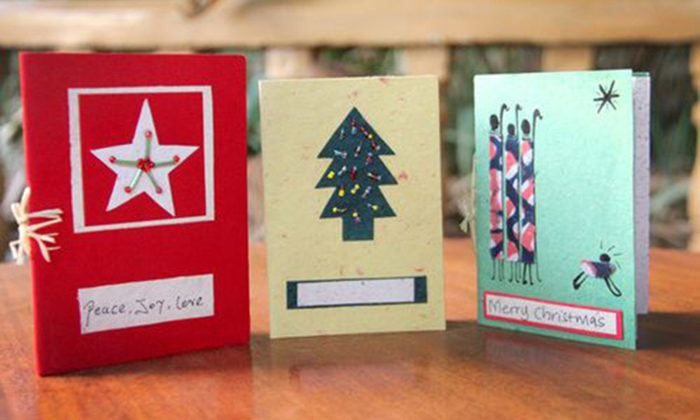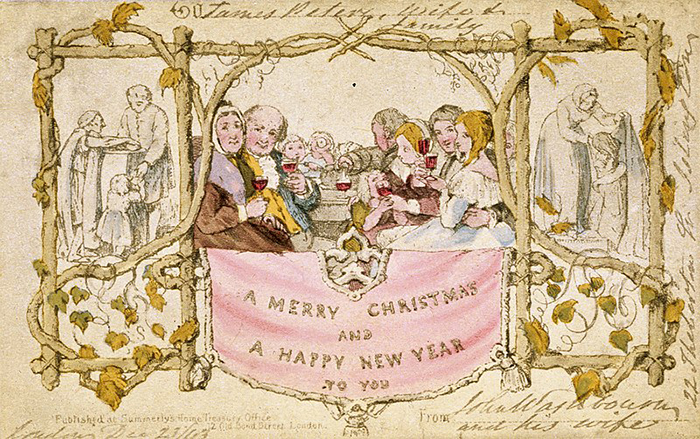
The custom of sending Christmas cards was started in the UK in 1843 by Sir Henry Cole. He was a senior civil servant (Government worker) who had helped set-up the new ‘Public Record Office’ (now called the Post Office), where he was an Assistant Keeper, and wondered how it could be used more by ordinary people.
Sir Henry had the idea of Christmas Cards with his friend John Horsley, who was an artist. They designed the first card and sold them for 1 shilling each. (That is only 5p or 8 cents today(!), but in those days it was worth much much more.) The card had three panels. The outer two panels showed people caring for the poor and in the center panel was a family having a large Christmas dinner! Some people didn’t like the card because it showed a child being given a glass of wine! About 1000 (or it might have been less!) were printed and sold. They are now very rare and cost thousands of Pounds or Dollars to buy now! The original cards were advertised with the slogan: “Just published, a Christmas Congratulations Card; or picture emblematical of old English festivity to perpetuate kind recollections between dear friends”!
The first postal service that ordinary people could use was started in 1840 when the first ‘Penny Post’ public postal deliveries began (Sir Henry Cole helped to introduce the Penny Post). Before that, only very rich people could afford to send anything in the post. The new Post Office was able to offer a Penny stamp because new railways were being built. These could carry much more post than the horse and carriage that had been used before. Also, trains could go a lot faster. Cards became even more popular in the UK when they could be posted in an unsealed envelope for one halfpenny – half the price of an ordinary letter.

As printing methods improved, Christmas cards became much more popular and were produced in large numbers from about 1860. In 1870 the cost of sending a post card, and also Christmas cards, dropped to half a penny. This meant even more people were able to send cards.
An engraved card by the artist William Egley, who illustrated some of Charles Dickens’s books, is on display in the British Museum. By the early 1900s, the custom had spread over Europe and had become especially popular in Germany.
The first cards usually had pictures of the Nativity scene on them. In late Victorian times, robins (a British bird) and snow-scenes became popular. In those times the postmen were nicknamed ‘Robin Postmen’ because of the red uniforms they wore. Snow-scenes were popular because they reminded people of the very bad winter that happened in the UK in 1836.
Christmas Cards appeared in the United States of America in the late 1840s, but were very expensive and most people couldn’t afford them. It 1875, Louis Prang, a printer who was originally from German but who had also worked on early cards in the UK, started mass producing cards so more people could afford to buy them. Mr Prang’s first cards featured flowers, plants, and children. In 1915, John C. Hall and two of his brothers created Hallmark Cards, who are still one of the biggest card makers today!
The first known ‘personalised’ Christmas Card was sent in 1891 by Annie Oakley, the famous sharpshooter and star of Buffalo Bill’s Wild West show. She was in Glasgow, Scotland at Christmas 1891 and sent cards back to her friends and family in the USA featuring a photo of her on it. As she was in Scotland, she’s wearing tartan in the photo! Annie reportedly designed the cards herself and they were printed by a local printer.
In the 1910s and 1920s, home made cards became popular. They were often unusual shapes and had things such as foil and ribbon on them. These were usually too delicate to send through the post and were given by hand.
Nowadays, cards have all sorts of pictures on them: jokes, winter pictures, Santa Claus or romantic scenes of life in past times. Charities often sell their own Christmas Cards as a way raising money at Christmas.
Charities also make money from seals or stickers used to seal the card envelopes. This custom started in Denmark in the early 1900s by a postal worker who thought it would be a good way for charities to raise money, as well as making the cards more decorative. It was a great success: over four million were sold in the first year! Soon Sweden and Norway adopted the custom and then it spread all over the continent.

